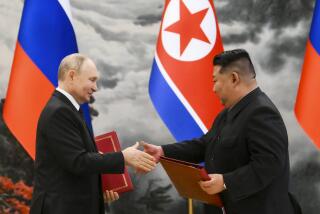U.S. to Acknowledge No Gun Ri Slayings Role
- Share via
WASHINGTON — U.S. and South Korean negotiators have reached a “mutual understanding” that American soldiers killed South Korean civilian refugees in the early weeks of the Korean War, but they left unresolved the question of how many died, a Clinton administration official said Friday.
The talks, which ended Thursday in Seoul with no publicly announced result, produced agreement from both sides that U.S. soldiers shot at the refugees near the hamlet of No Gun Ri in July 1950 and that there is insufficient evidence to conclude whether the soldiers acted on direct orders from superiors, the official said. The official discussed the matter on condition of anonymity.
The South Koreans had argued that there was enough evidence to say the killings were ordered, but the American side prevailed in describing the circumstances at No Gun Ri as chaotic and unclear, the U.S. official said.
As for casualties, the Koreans stuck to their figure of 248 killed, wounded or missing, and the Americans insisted that the number is much lower but cannot be determined exactly, the official said.
These results are based on the findings of separate U.S. and South Korean investigations. The U.S. inquiry found that American soldiers did shoot civilian refugees at No Gun Ri but that, while there were orders to regard refugees as hostile targets, there were no “shoot-to-kill” orders at No Gun Ri.
The agreement reached in Seoul has yet to be approved by Army Secretary Louis Caldera or top-level South Korean government officials. It also does not address the sticky question of whether the United States will compensate the survivors and families of those slain, issue an official apology or build a memorial to the victims.
The Army opposes compensating the families, the official said. The decision is expected to rest with President Clinton.
In Seoul on Friday, the South Korean parliament approved a resolution calling for a quick resolution of the issue. Reflecting South Korean frustration at the duration of the U.S. inquiry, the resolution stated, “The U.S. government is buried in investigating unessential and peripheral issues, raising questions over whether it has the will to resolve the incident.” It did not elaborate.
Caldera was widely expected to endorse both the agreed “statement of mutual understanding” and the conclusions reached in a yearlong investigation by Lt. Gen. Michael Ackerman, the Army’s inspector general.
It is unlikely that either the investigation report or the joint statement will be publicly released until January, Pentagon officials said.
Donald P. Gregg, a former U.S. ambassador to South Korea and chairman of an eight-member panel of civilian experts named by the Pentagon to oversee the Army investigators, did not immediately return a call seeking comment.
The South Korean government conducted its own investigation. The results have not been made public.
At Defense Secretary William S. Cohen’s instruction, Caldera initiated the inquiry Sept. 30, 1999, after the Associated Press reported on the killings in a series of stories that won the 2000 Pulitzer Prize for investigative reporting. The Army previously had insisted that there was no evidence of U.S. military involvement in the killings.
Cohen has not yet seen the Ackerman report, officials said, but he will get briefed on it soon.
The AP story quoted U.S. veterans as estimating that 100, 200 or simply hundreds died in the attacks July 26-28, 1950. Korean relatives of the victims, who filed suit seeking compensation, said 300 were killed under the railroad bridge near No Gun Ri and 100 in a prior strafing by U.S. Air Force planes.
The Ackerman investigation of No Gun Ri included interviews with more than 100 servicemen and a review of more than 1 million pages of documents. It found no written orders directing GIs at No Gun Ri to open fire that day even though there were orders to treat civilian refugees as hostile targets, according to American officials familiar with the report.
Among ex-GIs interviewed earlier by AP, about 20 who were at No Gun Ri recalled orders to shoot. Other veterans said they didn’t remember, or declined to talk.
Former Rep. Pete McCloskey (R-Calif.), a member of the civilian advisory panel led by Gregg, said he disagreed with the report’s conclusion that there was insufficient evidence of orders to fire on the refugees, and he urged a revision.
“We have seen statements from one officer and nine enlisted men at No Gun Ri who referred to those orders,” McCloskey said.
AP reported last month that two former soldiers who handled radio and message traffic had told Army investigators that American troops at No Gun Ri had orders from superiors to fire on civilians. Lawrence Levine and James Crume were assigned to the headquarters of 2nd Battalion, 7th Cavalry regiment. They were the first from a higher command level to support publicly the recollections of other veterans that they were ordered to shoot civilians for fear North Korean infiltrators were among them.
More to Read
Sign up for Essential California
The most important California stories and recommendations in your inbox every morning.
You may occasionally receive promotional content from the Los Angeles Times.










